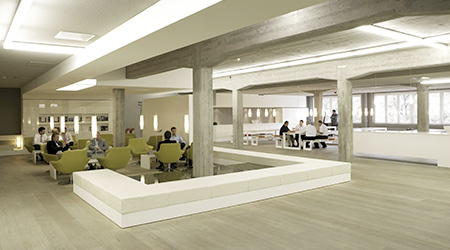SPONSORED
REHAU - Branded Feature
Evidence Shows Radiant Contributes to Healthier Buildings, Not Just Efficiency
Stakeholders Report Greater Comfort, Higher Productivity and Improved Safety with Advanced Hydronic Technologies
If you are closely following the green building movement, you already know that radiant heating and cooling systems are significantly more energy efficient than traditional HVAC. That's why advanced hydronic technologies are found in half of all the zero-net energy buildings in North America, according to the New Building Institute in Portland, Ore.
But something else remarkable and often overlooked is going on out there in hundreds of radiant building projects throughout North America. A growing body of evidence shows that radiant heating and cooling can enhance comfort, boost productivity and improve health and safety in the building environments where people live and work every day. Nowhere is this more evident than in buildings with particularly sensitive indoor environments such as schools, hospitals and senior care facilities.
One player at the forefront of this radiant big thinking is REHAU, a global designer and manufacturer of polymer-based solutions for automotive, appliance, furniture and building industries. "Of course, product excellence is a must," said Jonathan Bittenbender, director of engineering for REHAU's building solutions division. "But what really motivates us is the difference we are making in the lives of the people who live, learn, work and heal in the buildings our technologies support. And ultimately our contribution to a cleaner, more sustainable planet."
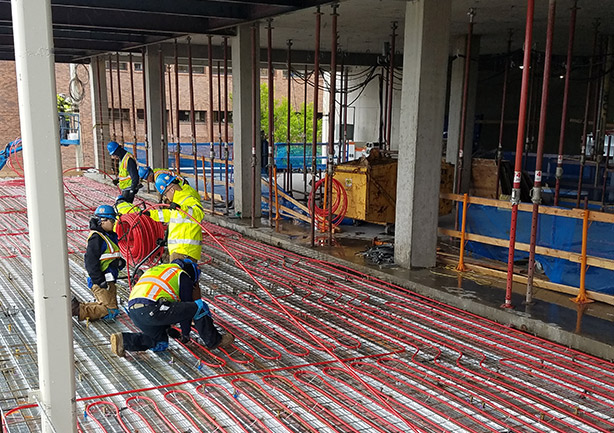
Radiant heating/cooling piping being installed at University of Washington Life Sciences Building.
©REHAU
3 Reasons Why Hybrid Radiant-Forced Air Beats Traditional HVAC on Comfort and Health
First, let's get on the same page regarding the "Why" behind the superior performance of radiant heating and cooling versus traditional HVAC solutions when it comes to comfort.
According the ASHRAE 55, the six primary factors for thermal comfort are metabolic rate, clothing insulation, air temperature, air speed, humidity and mean radiant (or surface) temperature. Forced-air systems adjust air temperature and counter humidity from outside air and from occupants within a building, but they can't actively control surface temperature. Radiant heating and cooling systems add an important dimension to comfort by adjusting the surface temperatures using fluid circulating through a network of PEX pipes hidden in the floors, ceilings or walls. Hybrid radiant-forced air systems are the optimal choice because they control the most human comfort variables.
- Constant, Gentle Heat
Radiant energy expands the range of comfortable temperatures in a space. Cold room surfaces remove warmth from your body, while energy radiating from warm surfaces allows your body to retain its warmth. Let's say you walk around the corner from the shady side of a building to the sunny side. You immediately feel warmer. The air temperature didn't change; the temperature of your surroundings did. By adjusting surface temperatures, radiant heating and cooling systems allow occupants to feel more comfortable at lower thermostat settings when heating (higher when cooling) than traditional air-based systems. Adding to this comfort level is the fact that radiant systems distribute energy more precisely and continuously, without the on-off fluctuations of air systems, putting an end to hot and cold spots.
- At Occupant Level
No surprise here, but floors are warmer when heated by in-slab radiant heating: Between 68 to 86°F versus 59 to 68°F without floor heating. While heated air rises above your head, radiant heating channels the warmth to the occupants. Surrounded by consistent, gentle heat, occupants are in harmony with their environment. It's not hard to imagine how radiant warmth can contribute to the comfort of children gathered around their kindergarten teacher for story time or residents lounging in a two-story atrium of a retirement home.
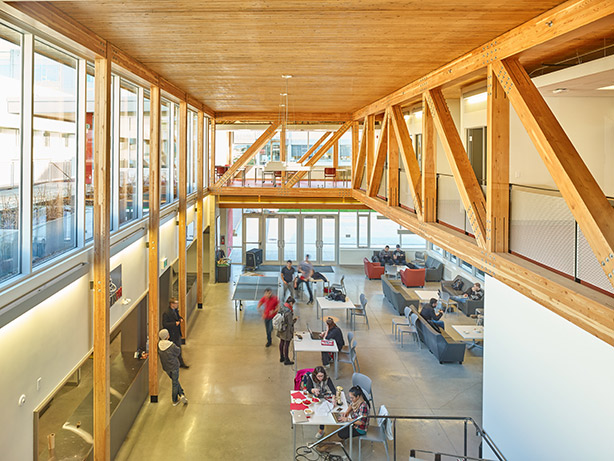
Radiant heating/cooling conditions the space at occupant level in University of British Columbia Engineering Student Centre.
Urban Arts Architecture I Photo: Martin Knowles ©
- With Improved Humidity Control
By separating temperature conditioning (sensible load) from dehumidification (latent load), a hybrid radiant-forced air system improves humidity control. Facility managers can independently and precisely control each of these human comfort variables. In a traditional forced-air system, there's a tendency to over-cool a space to achieve desired humidity levels. This not only wastes energy, but may send some occupants searching for individual space heaters. Considering both efficiency and comfort, radiant heating/cooling is an optimal combination with a dedicated outdoor air system (DOAS) for fresh air ventilation and humidity control.
Zoned for Optimal Occupant Comfort
As taxpayer funded institutions, schools and universities are often the trailblazers in green building initiatives that push the outer boundaries in energy efficiency and sustainability. They are also increasingly committed to creating comfortable learning environments, and with good reason.
Studies from different countries worldwide indicate that ventilation and thermal comfort are compromised in a large proportion of schools. This is particularly concerning because, with their higher metabolic rates and core body temperatures, children are more vulnerable to the effects of heat stress.
Unlike forced-air systems, radiant systems can be designed to target energy very accurately to rooms with different uses throughout a building using multiple zones.
Providing a comfortable, healthy and sustainably designed learning environment was the primary reason JSF High School (École secondaire Jeunes sans frontiers) near Toronto chose a radiant heating and cooling system.1 Running throughout the entire 90,000 ft2 facility, 100,000 ft of radiant pipe was networked to 42 zones for a comfortable, even method of heating and cooling that also helped JSF become the first secondary school building in Ontario to achieve LEED certification.
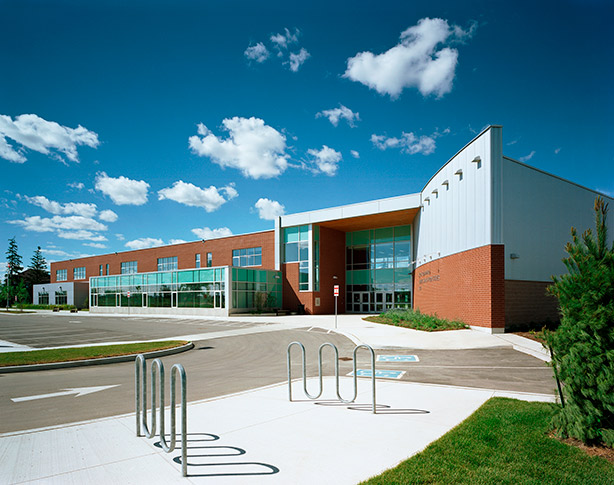
JSF High School chose radiant heating/cooling to create comfortable, healthy and sustainably designed environment.
Robertson Simmons architects inc. I Photo: Patrick Kennedy ©
While developing plans for their new Campus North Residential Commons, administrators at the University of Chicago embraced the opportunity to build an innovative facility that students would be happy to call home.2 Todd Zima, design principal at Studio Gang, said the radiant heating and cooling system was chosen early in the project for the dorm rooms in order to improve building energy efficiency and enhance comfort for the students. By circulating heated or chilled water through 5/8-inch piping installed in the ceilings on each floor, the hydronic system maintains the spaces at even, comfortable temperatures while using less energy than traditional forced-air systems. An added benefit of this technology is that students don't have to use thermostats. Each floor is equipped with four zones, each with two sensors that adjust the radiant ceiling slab temperature dynamically depending on the outside temperature, the solar radiation and the orientation of the zone.
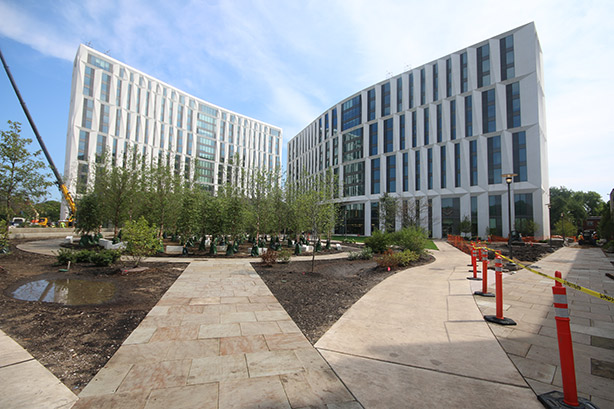
Radiant heating/cooling in dorm rooms at University of Chicago Campus North Residential Commons helps to improve building energy efficiency and enhance comfort.
Photo courtesy of University of Chicago ©
Improved Comfort, Air Quality Boosts Performance
So how do the advantages inherent in radiant play out in the buildings where we live, work, learn and heal? How does a comfortable environment help people to focus on achieving what really matters to them–whether it's passing a test, winning a game of cards or making a speedy recovery.
While thermal comfort is well defined and widely studied in building science, the impact of thermal conditions goes beyond comfort. Researchers at the Harvard T.H. Chan School of Public Health in Schools for Health: Foundations for Student Success recently coined the term "thermal health" to explore the impacts of thermal conditions on health, cognitive function and performance. This report reviews findings from more than 200 scientific studies that point to positive and negative effects of the indoor environments of schools on student health and performance.
Several large-scale studies have concluded that uncomfortably high indoor temperatures adversely affect performance. For example: A study of 75,000 high school students in New York City found that students were 12.3% more likely to fail an exam on a 90°F day versus a 75°F day.3
Radiant Heat Can Improve Physical and Emotional Wellbeing
Health care administrators at hospitals and clinics, as well as care providers at retirement homes and assisted-living facilities, are also discovering that the benefits of radiant go beyond reduced energy and maintenance costs. The ability of hybrid radiant-forced air systems to separately control humidity and temperature can be particularly advantageous in these settings.
Each winter, the flu poses serious risk particularly for vulnerable groups such as the elderly and children. In addition to flu shots and hand sanitizing, research has shown that increasing indoor humidity levels is an effective way to reduce the spread of influenza infection. A study on guinea pigs found that when relative humidity (rh) was maintained above 40%, only a fraction of airborne influenza virus particles caused illness, compared with a transmission rate of 70% percent when the rh was around 20%. The conclusion: Maintaining indoor rh levels between 40% and 60% to protect health will benefit all building occupants.4
For populations that are more susceptible to distractions, radiant offers the added benefit of much quieter operation than traditional HVAC. Because the systems use low-velocity pumps to push liquid through piping embedded in floors, ceilings or structural beams, they make so little noise they're nearly impossible to detect.
That's why the Sweetwater Spectrum community, a three-acre, mini-campus in northern California with homes and community centers for adults with autism, chose radiant heating and cooling.5 Hypersensitivity to noise is a commonly reported challenge for people with autism. Sweetwater wanted to utilize the highly manageable comfort of radiant heating and cooling and capture its sustainable energy efficiencies while also providing as quiet an environment as possible.
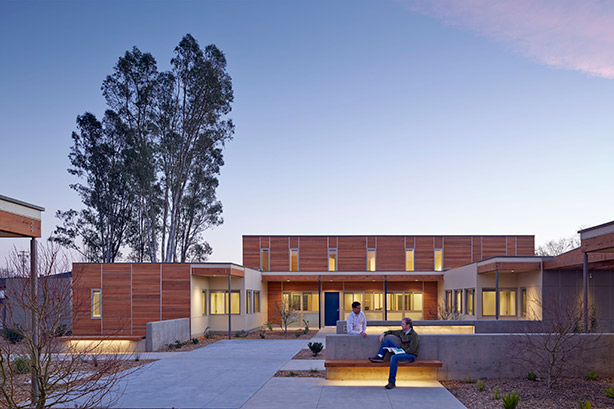
Sweetwater Spectrum community for adults with autism chose radiant heating and cooling to create a quiet environment.
Leddy Maytum Stacy Architects I Photo: Tim Griffith ©
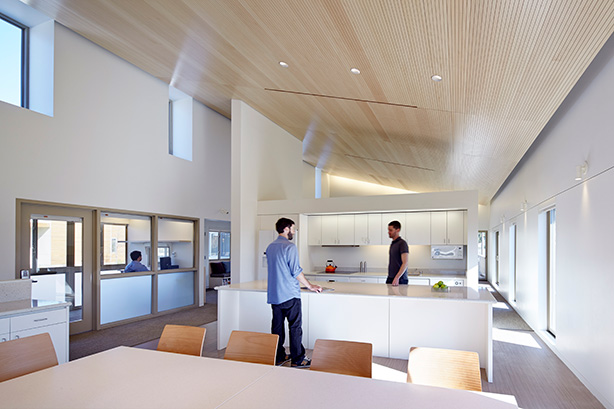
Sweetwater Spectrum community for adults with autism chose radiant heating/cooling to create a quiet environment.
Leddy Maytum Stacy Architects I Photo: Kyle Jeffers ©
"Controlling all sensory aspects of the living environment to the best of our ability was key to this project, particularly as we wanted to establish a successful model that could be replicated to address the need for this type of community across the country," said Mark Jackson, president of Sweetwater Spectrum at the time of construction. "Including quiet, efficient HVAC systems in the residents' living spaces and recreation area was part of the way in which we sought to achieve this goal."
As one of Canada's most innovative and energy-efficient buildings, the 60,000 ft2 Earth Rangers Centre in Woodbridge, Ontario, functions as a wildlife refuge and hospital and as an education center for children.6 In addition to sustainability, good ventilation and comfortable living conditions for the ailing animals were a priority for this health care facility. Building designers placed radiant in the floors and ceilings–as well as in the cast-in-place skylights–in order to collect, distribute and maximize solar gain. If the treatment and rehabilitation of this building's special residents–beavers, deep, raptors and songbirds, to name a few–is enhanced by thermal comfort, shouldn't we provide human occupants of hospitals the same benefits?
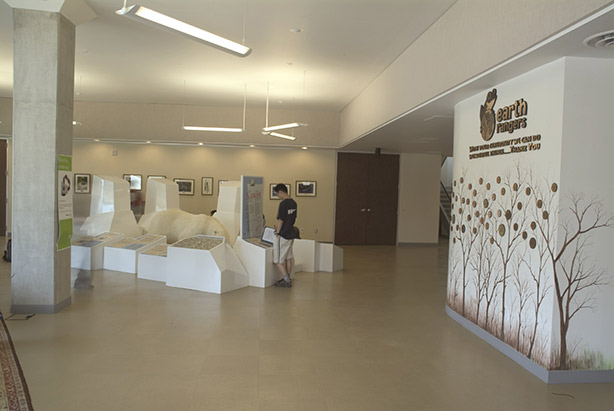
Radiant heating/cooling supports comfortable living conditions for ailing animals at Earth Rangers Centre.
©REHAU
Hydronic Technologies Create Safer Outdoor Environments Too
The advantages of hydronic technologies don't stop at the doors of these buildings.
Radiant snow and ice melting (SIM) systems reduce risk of injury for teachers, students, patients, visitors and health care workers by melting snow and ice from sidewalks, driveways and entrances. SIM controls enable these systems to work automatically at the first sign of snow or ice when a network of pipes circulate a heated solution (usually water plus glycol) beneath the surface (e.g., brick, asphalt or concrete).
The Kitchener-Waterloo Hospital in Ontario installed a hydronic SIM system to enhance sidewalk, entrance and driveway safety–and help mitigate legal liability along the way–without new investments in expensive snow-ice removal equipment and added labor costs.
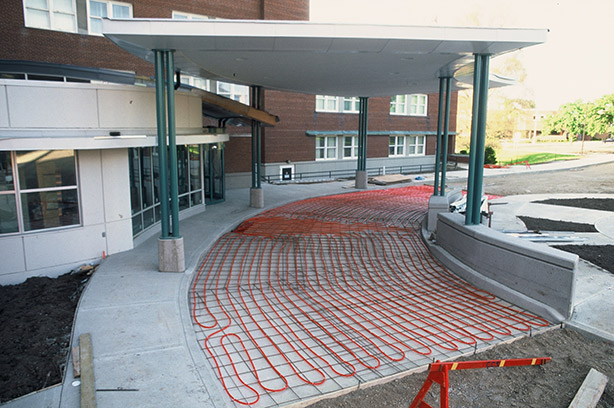
Hydronic SIM system enhances sidewalk, entrance and driveway safety Kitchener-Waterloo Hospital.
©REHAU
Snow and ice melt systems also have a sustainable benefit: They allow building managers to control snow and ice without the use of caustic chemicals and de-icing salts that can pollute streams, waterways and landscaping while ruining entryway flooring and carpet.
Elevating Sustainability, Enhancing Lives
Now we'll bring this story on radiant technologies right back to where it started: Industry-wide recognition of superior energy performance plus previously unheralded advantages in comfort, productivity and safety.
"It's a basic principle of physics that water distributes energy much more efficiently than air," said Anthony Alterio, account representative with REHAU's building solutions division. "Therefore, you're able to get more heat at a lower water temperature with radiant than you can with forced-air alone."
"Radiant systems allow building operators, managers and owners to do much more with much less energy," Alterio continued, "up to 30 percent less–and even higher when coupled with other hydronic technologies like our pre-insulated district energy piping and geothermal ground loop heat exchangers. And don't forget, radiant is also easier to operate and maintain than forced air," he added.
Here's one more study to pull this all together: To test the performance of radiant versus forced air, the Infosys Software Development Block office building was built by the global high tech leader in central India. Designers divided the 250,000 ft2 building in two–one half cooled with forced air only, the other with a hybrid radiant forced-air system.7 Data analysis by the Technical University of Braunschweig found that the radiant cooling system used 33% less energy than the forced-air system.
The findings of a follow-up survey of the building's 2,500 occupants by the University of California Berkley's Center for the Built Environment may have been even more telling; Radiant also scored higher on thermal comfort. The workers on the radiant-cooled side of the building felt the rooms were cooler despite the fact that the indoor air temperature actually measured 3.6 degrees warmer. More comfort with significantly reduced cooling energy–why wouldn't every building owner want this?
"It's an exciting time to be in this field," said Bittenbender. "We're seizing the possibilities of a changing world to create solutions for individual needs and take responsibility for ecological issues. By making the built environment smarter, we are able to help occupants focus on what really matters."
For more information, click here
REHAU is the premium worldwide brand for polymer-based innovations and systems in construction, automotive and industry. The company's highly engineered building solutions support the creation of sustainable and healthy environments that enhance the productivity, comfort and safety of people that live and work in them.
Citations
1 https://www.rehau.com/us-en/mechanical-and-plumbing/radiant-heating-and-cooling/project-profiles-heating/jsf-high-school
2 https://www.rehau.com/us-en/mechanical-and-plumbing/radiant-heating-and-cooling/project-profiles-heating/university-of-chicago-
3 https://forhealth.org/Harvard.Schools_For_Health.Foundations_for_Student_Success.pdf
4 https://www.esmagazine.com/articles/98691-have-you-vaccinated-your-building
5 https://www.rehau.com/us-en/mechanical-and-plumbing/radiant-heating-and-cooling/project-profiles-heating/sweetwater-spectrum
6 https://www.rehau.com/us-en/mechanical-and-plumbing/radiant-heating-and-cooling/project-profiles-heating/earth-rangers
7 https://www.rehau.com/us-en/mechanical-and-plumbing/radiant-heating-and-cooling/project-profiles-heating/infosys-sbd1








